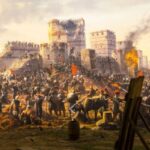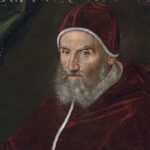We explain what the Protestant Reformation was, its origin, consequences and characteristics. Also, more important characters.

What was the Protestant Reformation?
It is known as the “Protestant Reformation” or “Protestant Revolution” to a religious movement of the 16th century led by the theologians Martin Luther (1438-1546) and John Calvin (1509-1564).
This movement generated a division within Catholicism which gave rise to the different churches that did not obey the leadership of the Pope as supreme representative of the Christian faith. The Reformation arose as a result of discontent generated by the way in which the Catholic Church administered religion. The elementary Catholic precepts of the Holy Scriptures were reviewed and religious practice was transformed in several aspects.
His initial act was the writing and dissemination of Luther's “ninety-five theses” in 1517, a text in which he criticized the sale of indulgences by the Catholic Church to raise funds and build the Sistine Chapel. Luther maintained that it was necessary reform the current church to resume the original practice of the Christian faith which had been lost due to the corruption of the powers of the papacy.
The princes of the German states supported Luther's denunciations by signing the Speyer Protest, in which they refused to submit to the power of the Catholic pope.
Since then, different clerics and rulers from other parts of Europe joined the reform movement and they organized their own Christian churches. In other cases, they supported the papacy and the Counter-Reformation movement.
The Counter-Reformation
The church, headed by the Pope, organized the “Counter-Reformation,” the theological movement that legitimized traditional actions and its ecclesiastical organization.
The reformists were persecuted by the Holy Catholic Inquisition in numerous countries. The process initiated by Luther culminated in the victory of the papacy, but weakened its power in northern Europe.
Characteristics of the Protestant Reformation
Some characteristics of the Protestant Reformation were:
- It proposes resuming the “original” spirit of Christianity, from which Catholicism had departed It does not recognize papal or ecclesiastical authority to define the Christian faith.
- Consider that only through the Holy Scriptures can the truth of God be understood. He urges the translation of the Bible into different languages and its reading and interpretation by clerics and believers.
- He maintains that faith is the only way to save souls. The indulgences and pardons granted by priests were not backed by divine power.
- He denounced the corruption and behavior of many Catholic priests. Protestants criticized their civil privileges and claimed that priests are no closer to God than the rest of believers. Furthermore, they suppressed ecclesiastical hierarchies and maintained that Jesus was the only intermediary between the individual and God.
- He highlighted the importance of baptism and the Eucharist and they eliminated the rest of the sacraments.
- Laid the groundwork for the division of the church. He proposed different ways of interpreting Christian faith and practice; the Lutheran Church, Anglicanism, Calvinism and other “radical” reforms.
Origins of the Protestant Reformation

By the beginning of the 16th century, The Catholic Church considered the Pope to be the highest authority in matters of faith and established an ecclesiastical hierarchy that allowed control, in a pyramidal manner, of Christian practice.
The power of the Pope, said to be backed by God, reached into earthly matters that exceeded the administration of religion. His power was political, due to the pressure he could exert on rulers affiliated with the Catholic faith and economic, because the Church was the owner of large properties and fiefs throughout Europe. This ecclesiastical hierarchy protected, in turn, the actions of the clerics in their own churches.
At this time, in addition, the Sistine Chapel was being built in the Vatican, which generated an extra need for income to pay for it.
Among the different sacraments administered by Catholic clerics, There were “indulgences” or pardons that the priest granted to the believer in the name of God. It was common at that time for believers to give donations in exchange for these spiritual favors. For many, this summed up the fraud and corruption that constituted Catholic proceedings.
In turn, the papal power of excommunication allowed the Pope to exert a constant threat on those who challenged his power or directly confronted clerical actions.
Excommunication not only meant expulsion from the Christian faith, but also, in many cases, expulsion from the political community to which one belonged. This explains the risk that Luther took when publishing his Disputatio pro declaratione virtus indulgentiarum (“Questioning the power and effectiveness of indulgences”) at the doors of the main temples of their city.
Causes of the Protestant Reformation
The Protestant Reformation did not have a single cause, but was due to various processes at the same time. We can summarize its causes in:
- The boredom of many European countries with the payment of papal taxes and the rejection of the control exercised from Rome by the papal delegates.
- The abundant accusations of corruption, lack of faith and ill will made against the Catholic Church, the Pope and the ecclesiastical hierarchy
- The promulgation of the statutes of Mortmain (1279), Provisors (1351) and Praemunire (1393), which reduced the Church's control over land control in some countries.
- The state of poverty of the Holy Roman Empire, including its noble classes, eager to share the assets owned in their nation by the Catholic Church.
Consequences of the Protestant Reformation

The Protestant Reformation was an event of enormous significance in the cultural history of Europe and, therefore, of the entire West. Among its consequences are:
- The division of the Christian faithful into two large aspects: the Catholic and the Protestant (made up of different churches and visions of the creed).
- The cultural distance between the countries of Mediterranean and Catholic Europe, and the Protestant countries of the north.
- Profound cultural changes in the values and philosophy of Protestant nations, many of which later influenced the rise of capitalism.
- The emergence of the Counter-Reformation as a movement opposing the Reformation, which had an enormous influence on the culture of Hispanic America.
Reformation and Counter-Reformation
The Popish movement was called the Counter-Reformation in response to the Protestant Reformation: A “renaissance” of the faith was enacted that sought to strengthen the traditional values of the Catholic creed, papal authority, and the medieval Christian heritage.
It was presented as the authentic and true form of Christian worship, trying to address the criticisms of Luther and other Protestant thinkers, which they considered heresies or deviations from the Christian faith.
Beginning with the Council of Trent, which began in 1545 and met for almost 17 years, new disciplinary measures were established for Catholic priests seminaries were created to organize the teaching of the faith and the precepts of the Roman Catholic Apostolic Church were reviewed and affirmed.
Besides, The actions of ancient Catholic orders such as the Discalced Carmelites were strengthened or the Society of Jesus, whose charisma in pursuit of earthly poverty and closeness to the most needy believers balanced the balance against the criticism of wealth from the papal aristocracy.
Most important figures of the Protestant Reformation

The most relevant historical figures in the Protestant Reformation were:
- Martin Luther. Founder of Lutheran doctrine, he was not only a critic of Catholicism, but also an important translator of the Bible into German, a version that was established as a model for the translation of the sacred text into the German language. He married Catherine of Bora in 1525, which started a movement supporting priestly marriage.
- John Calvin. He was another of the great Protestant reformers, the author of a series of doctrines that later founded “Calvinism”, contrasted with those of the Dutch Protestant Jacob Arminio. He was the creator of the Geneva Bible in 1564, as well as The Institution of the Christian Religionfrom 1536.
- Ulrich Zwingli. Leader of the Protestant Reformation in Switzerland, born in 1484 and died in 1531, he was also the founder of the Swiss Reformed Church, and studied the Holy Scriptures from a point of view strongly influenced by Humanism. His conclusions, similar to those of Luther, were obtained independently, and between 1524 and 1529 he translated the Bible into German, with marked Swiss characteristics. This text is known as the Zurich Bible.
- Jacob Arminio. Born in 1560 and died in 1609, he was a writer and professor at the University of Leiden, as well as an important Dutch Protestant theologian. He was the founder of the anti-Calvinist Protestant school, and his legacy was important for the rise of Methodism.
Continue with: Religious norms
References
- “Protestant Reformation” on Wikipedia.
- “The Protestant Reformation and Luther” (video) on Academia Play.
- “Protestant Reformation” in Enciclopedia.us.
- “History 101: The Protestant Reformation” in National Geographic.
- “Martin Luther and the 95 Theses” on History.com.
- “Reformation (Christianity)” in The Encyclopaedia Britannica.
- Miegge, M. (2017). Martin Luther: the Protestant Reformation and the birth of modern society. Clie Publishing.
- Plans, J.B. (2019). Catholic Reformation and Protestant Reformation. Its cultural impact. Hippogriff. Magazine of literature and culture of the Golden Age, 7(2), 333-347.
- Chávez, HD, & Aguilar, RAC The Protestant Reformation.





